Dione juno
Margarita BeltránIntroduction
Etymology: Juno was a Roman goddess, the equivalent of the Greek Hera, queen of the gods. Juno was a majestical figure, wearing a diadem on her head. The peacock is her symbolic animal. Juno is also the guardian of the Empire's finances and considered the Matron Goddess of all Rome. The month of June was named after her (JUNO).
Characteristics
Early stages: Eggs are red and approximately 1 x 0.7 mm (h x w). Females usually place 60 to 100 eggs under leaves of the host plant. Mature larvae have a brown body with orange spots, with black scoli and head; length is around 0.1 cm. Caterpillars are gregarious (Brown, 1981).

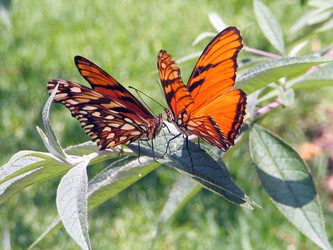

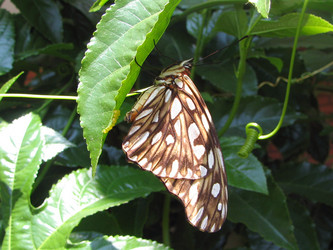

Clockwise from top left: Dione juno courtship: Courting ritual. The male butterfly expands and flaps the wings in front of the female and flutters around. Mating pair. Female ovipositing. A cluster of eggs two days after they were laid. Mexico City, © Maria Franco

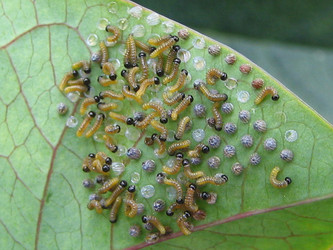
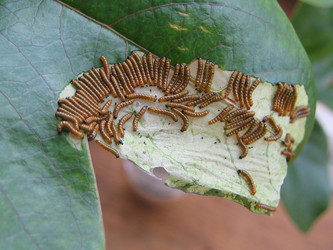
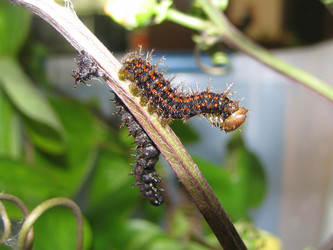
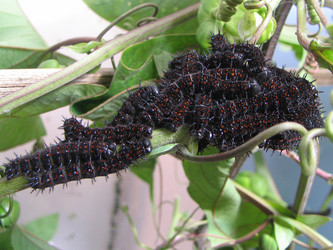
Clockwise from top left: Dione juno first instar larvae hatching 12 days after oviposition. Gregarious larvae four days after hatching. Freshhly moulted last instar larva. Gregarious last instar larvae. Mexico City, © Maria Franco

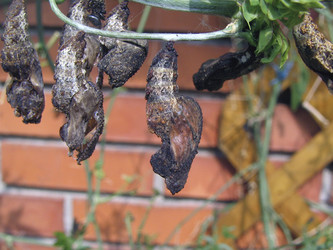


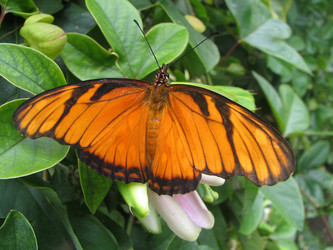
Clockwise from top left: Dione juno pupa about to eclose. Butterfly eclosing. Freshly eclosed butterfly expanding wings. Freshly eclosed butterfly with expanded wings. Mexico City, © Maria Franco
Habits
Dione juno occurs from sea level to 1200 m in open forests. Usually individuals fly rapidly in the middlestory. Adults roost in loose groups at night lower than 2 m above ground on grass blades and leaves (Brown, 1981, DeVries, 1997).
Hostplant: D. juno larvae feed primarily on plants from the genus Distephana, Tacsonia, Grandilla and Plectostema (Brown, 1981). In Costa Rica D. juno feed on Passiflora vitifolia, P. alata, P. platyloba, and P. edulis (DeVries, 1997).
References
Brown K. S. 1981 The Biology of Heliconius and Related Genera. Annual Review of Entomology 26, 427-456.
Cramer P. 1979 De uitlandische Kapellen voorkomende in de drie Waereld-Deelen Asia, Africa en America. Papillons exotiques des trois parties du monde l'Asie, l'Afrique et l'Amérique. Amsteldam, S. J. Baalde; Utrecht, Barthelemy Wild and J. Van Schoonho-ven & Comp. 3(17/22): 1-128, pls. 193-264
DeVries P. J. 1997 The Butterflies of Costa Rica and Their Natural History, Volume I: Papilionidae, Pieridae, Nymphalidae Princeton University Press, Baskerville, USA.
JUNO. UNRV Hystory. http://www.unrv.com/culture/major-roman-god-list.php [Accessed 2 Sept 2008]
Title Illustrations

| Scientific Name | Dione juno |
|---|---|
| Specimen Condition | Dead Specimen |
| View | dorsal |
| Collection | Gerardo Lamas |
| Image Use |
 This media file is licensed under the Creative Commons Attribution-NonCommercial-ShareAlike License - Version 3.0. This media file is licensed under the Creative Commons Attribution-NonCommercial-ShareAlike License - Version 3.0.
|
| Copyright |
©

|
| Scientific Name | Dione juno |
|---|---|
| Specimen Condition | Dead Specimen |
| View | ventral |
| Collection | Gerardo Lamas |
| Image Use |
 This media file is licensed under the Creative Commons Attribution-NonCommercial-ShareAlike License - Version 3.0. This media file is licensed under the Creative Commons Attribution-NonCommercial-ShareAlike License - Version 3.0.
|
| Copyright |
©

|
About This Page

University of Cambridge, Cambridge, UK
Correspondence regarding this page should be directed to Margarita Beltrán at
Page copyright © 2006
 Page: Tree of Life
Dione juno .
Authored by
Margarita Beltrán.
The TEXT of this page is licensed under the
Creative Commons Attribution-NonCommercial-ShareAlike License - Version 3.0. Note that images and other media
featured on this page are each governed by their own license, and they may or may not be available
for reuse. Click on an image or a media link to access the media data window, which provides the
relevant licensing information. For the general terms and conditions of ToL material reuse and
redistribution, please see the Tree of Life Copyright
Policies.
Page: Tree of Life
Dione juno .
Authored by
Margarita Beltrán.
The TEXT of this page is licensed under the
Creative Commons Attribution-NonCommercial-ShareAlike License - Version 3.0. Note that images and other media
featured on this page are each governed by their own license, and they may or may not be available
for reuse. Click on an image or a media link to access the media data window, which provides the
relevant licensing information. For the general terms and conditions of ToL material reuse and
redistribution, please see the Tree of Life Copyright
Policies.
- First online 18 February 2007
- Content changed 04 September 2008
Citing this page:
Beltrán, Margarita. 2008. Dione juno . Version 04 September 2008 (under construction). http://tolweb.org/Dione_juno/72863/2008.09.04 in The Tree of Life Web Project, http://tolweb.org/





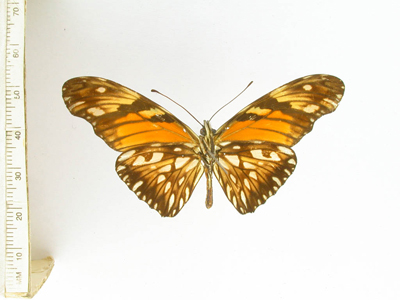




 Go to quick links
Go to quick search
Go to navigation for this section of the ToL site
Go to detailed links for the ToL site
Go to quick links
Go to quick search
Go to navigation for this section of the ToL site
Go to detailed links for the ToL site